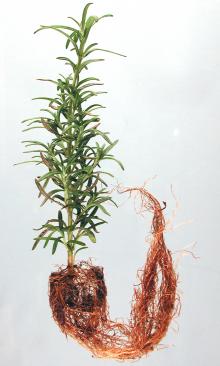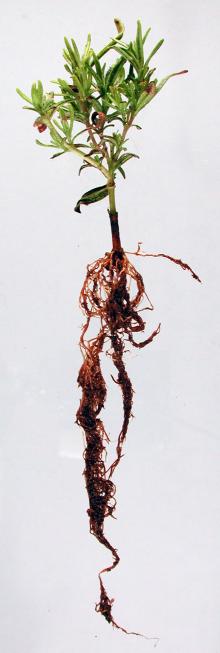Cause Several root rotting organisms have been detected in rosemary root rot samples coming to the OSU Plant Clinic. Pythium, Berkeleyomyces sp. (formerly Thielaviopsis basicola), and Rhizoctonia are among the organisms found. Rosemary is native to seaside cliffs and thus over watering and too much fertility inhibit good growth. These same soil conditions favor many root-rot organisms.
Symptoms Root or root crown rots result in the yellowing and dying of leaves. Whole branches or plants may become brown. Leaf tips may also become dark brown.
Roots affected by black root rot will initially be brown and could be mistaken for Rhizoctonia root rot. The diagnostic: flat, black root lesions occur when spores form on the root surface and in the root cortex.
Root systems affected by Pythium are dark brown and this symptom may extend up into the root crown and stems.
Cultural control
- Good drainage is essential in pots or the landscape.
- Water and fertilize lightly.
- Use new trays and pots with clean soilless media. If pots must be reused then wash off all debris and soak in a sanitizing solution or treat with aerated steam for 30 min.
- Preplant soil solarization has been helpful in reducing populations of certain soilborne pathogens and weeds in western Oregon. Place clear plastic (preferably anti-condensation film) directly on smooth, rototilled ground, which has been irrigated to field capacity and then allowed to drain for 1-2 days. Bury the edges of the plastic to trap the heat. Solarize for 4-6 weeks (or longer) during the hottest part of the summer, beginning in early- to mid-July.
Chemical control Focus on cultural-management tactics first and use chemicals only to supplement production.
- Fosphite at 1 to 3 quarts/100 gal water. Do not use spray adjuvants. Group P7 fungicide. 4-hr reentry.
- Monterey Garden Phos at 1 teaspoons/8 gal water as a soil drench. Group P7 fungicide. H
- Ridomil Gold SL at 1 to 2 pints/A if Pythium is a problem. Can apply as a surface application or in a 7-inch band according to label rates. May be incorporated to 2-inches deep. Do not apply within 21 days of harvest. Group 4 fungicide. 48-hr reentry.
Biological control Use in conjunction with other control tactics.
- Bio-Tam 2.0, Tenet WP, or Obtego (Trichoderma asperellum and T. gamsii) at 0.5 to 1.5 lb/cubic yard of substrate. See label for details and other application methods. No restrictions on reentry when soil incorporated. O
Reference Ashrafi, S.J., Rastegar, M.F., and Saremi, H. 2010. Rosemary wilting disease and its management by soil solarization technique in Iran. African Journal of Biotechnology 9:7048-7057.



